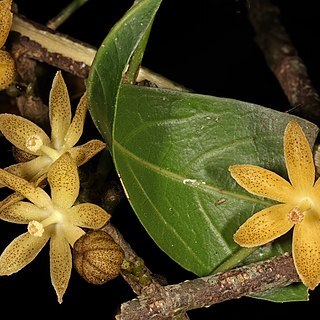Tree 3-15 m high, evergreen, monoecious or dioecious, ‘bark flaking off in small patches’; branchlets glabrescent. Stipules early caducous, not seen except on seedlings, subulate-acuminate, ±6 mm long. Leaves simple, entire; blade obovate-elliptic, usually narrowly so, shortly and broadly narrowing to, or acuminate at, the apex, narrowing from above the middle to the base, 7-20 cm long, 1-6.5 cm broad, glabrous at maturity, young leaves sparsely stellate with short hairs, midrib prominent, especially on under surface, with 7-12 or more distinct lateral nerves; petioles 1-4 cm long, with a slight thickening (pulvinus), 5-10 mm long, at the apex; pulvinus glabrescent. Inflorescence 1-flowered, axillary, solitary or fascicled, or from below leaves and on old wood, usually clustered on a much abbreviated shoot, 2 to several in a cluster; bracts at base, 1.5-2 mm long, 1.5-2 mm broad, early deciduous; pedicels 3-7 mm long, up to 1 mm diam., articulated about midway, and with scars of 1-2 bracts; densely stellate-tomentose at first, hairs short, less than 0.5 mm long, light or dark brown. Calyx 5-lobed almost to base, densely brown stellate-pubescent without; lobes 4-8 mm long 1.5-4.5 mm broad, lepidote within and with a few scattered brown stellate hairs in upper half. Male flower with staminal-tube glabrous or minutely stellate in basal portion, 1.5-5 mm long, anthers 8 in 1 row at the apex, cells parallel, 1 mm long, rudimentary ovary and 5 styles in anther ring. Female flower with sessile ovary, 4-5 carpellate, about 2 mm diam., with a ring of rudimentary stamens round the base; styles 5, sometimes fewer, with club-shaped recurved, stigmas; ovules 2 or 3 in each cell. Carpels 4-5, or by abortion fewer, obovate-globose, about 4 cm long, 3 cm diam., densely microscopically scaly and stellate-pubescent, hairs very short or worn off, rind hard (often tuberculate through insect activity), ripe fruit orange to salmony yellow, glutinous inside; seeds 2, or sometimes 3, cotyledons thick, creamy white and deep pinkish red tinged on inner face and with resinous ducts, in part minutely stellate-pubescent.
More
Tree, 3-15 m high; dioecious or monoecious; bark flaking. Leaves entire, obovate-elliptic, glabrous; petioles with swollen apical portion (pulvinus), glabrescent. Flowers in axillary clusters, cymes, small panicles or solitary, sometimes on old wood. Calyx 5-lobed almost to base. Petals absent. Male flowers with staminal tube; anthers 8 in 1 row at apex; ovary rudimentary. Female flowers: carpels 4 or 5, with a ring of rudimentary stamens at base; styles as many as carpels. Fruit splitting into 4 or 5 carpels; obovate, up to 40 mm long, orange to salmony yellow, rind hard and thick. Seeds 2 or 3.
A small or medium sized tree. It grows 7-10 m high. The bark is grey. It is smooth and peels in small flakes. The young branches are hairy. The leaves are oval and 6-20 cm long by 1.5-6 cm wide. They are dark green. The leaf tapers to both ends. The leaf stalk is 2,5 cm long. The flowers are in clusters in the axils of leaves. The fruit is made up of 2-4 carpels each 4 cm long by 2.7 cm wide. They are leathery. The surface is rough and there are yellowish hairs.


